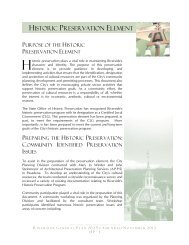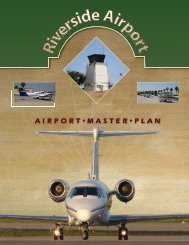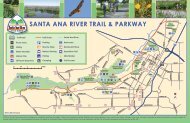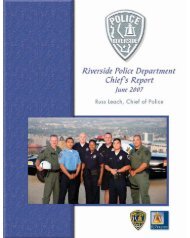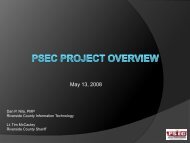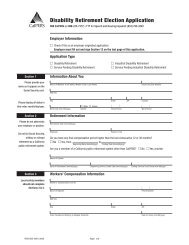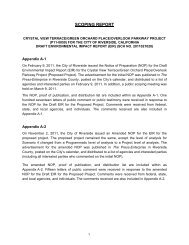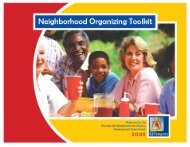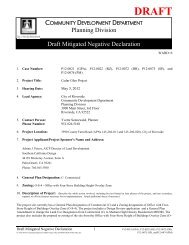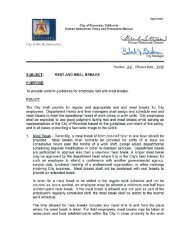Northside - City of Riverside
Northside - City of Riverside
Northside - City of Riverside
You also want an ePaper? Increase the reach of your titles
YUMPU automatically turns print PDFs into web optimized ePapers that Google loves.
doubled, with the largest jump occurring between 1900 and 1910 when the number<br />
<strong>of</strong> residents soared from 7,973 to 15,212 (Census Bureau, Census 1900-1920).<br />
Perhaps more than the simple addition <strong>of</strong> <strong>Riverside</strong> natives over these years, this<br />
local population growth may be fueled by an influx <strong>of</strong> people from regional or<br />
national locales who sought to reverse their finances in a town, which by now must<br />
have a established an even-keeled reputation for riding out both the boom times and<br />
the down times as experienced in the last decades <strong>of</strong> the 19 th century, perhaps to try<br />
their hand at citriculture. While the <strong>City</strong>scape grew increasingly larger through the<br />
efforts <strong>of</strong> Miller and other boosters and the addition <strong>of</strong> fine public, civic, and<br />
research facilities on a grand scale, the sheer numbers <strong>of</strong> people looking to settle<br />
made the face <strong>of</strong> <strong>Riverside</strong>’s neighborhoods like those <strong>of</strong> the <strong>Northside</strong> largely into<br />
compact, modest-scaled streets.<br />
COMMUNITY DEVELOPMENT<br />
Residents <strong>of</strong> the <strong>Northside</strong> continued to enjoy the neighborhood places and spaces<br />
<strong>of</strong> informal recreation established in the earliest period <strong>of</strong> development like<br />
Fairmount Park and White Sulphur Springs, and during this period, an established<br />
<strong>Riverside</strong> attraction was relocated to the <strong>Northside</strong> – the <strong>Riverside</strong> County/<br />
Southern California Fair - and became associated with Fairmount Park. The historic<br />
<strong>Riverside</strong> Fairgrounds border the survey area, but as with other early areas <strong>of</strong><br />
recreation, their significance to residents within the <strong>Northside</strong> warrants inclusion<br />
here. In addition, the <strong>Northside</strong> gained an elementary school during this period –<br />
Fremont Elementary – that is located just north <strong>of</strong> SR-60.<br />
<strong>Riverside</strong> Fairgrounds<br />
The former <strong>Riverside</strong> Fairgrounds is located within the <strong>Northside</strong>, just northwest <strong>of</strong><br />
the survey boundaries. The fairgrounds located in the area roughly bounded by<br />
Strong Street to the north, Fairmount Boulevard to the east, the<br />
Crestmore/<strong>Riverside</strong>-Rialto Line <strong>of</strong> the PE (later Crescent <strong>City</strong> Railway) roadway<br />
(now the Market Street alignment) to the south and the Santa Ana River to the west,<br />
near the northern edge <strong>of</strong> Fairmount Park. While in operation, the fairgrounds were<br />
commonly associated with the parkland by area residents but the connection was<br />
severed by the construction <strong>of</strong> SR-60 through the area in 1960-63. Fairgrounds Street<br />
is still extant alongside the freeway to the north.<br />
Before the area was developed for use as a fairground, a county fair was held for a<br />
number <strong>of</strong> years at Chemawa Park (8830 Magnolia Avenue), a 23-acre community<br />
space owned and maintained by the Pacific Electric Railway. Chemawa Park opened<br />
in the late 1890s and provided open space for leisurely pastimes, such as picnicking,<br />
fairs and athletic recreation. According to long-time resident Theresa Gordon, the<br />
81



